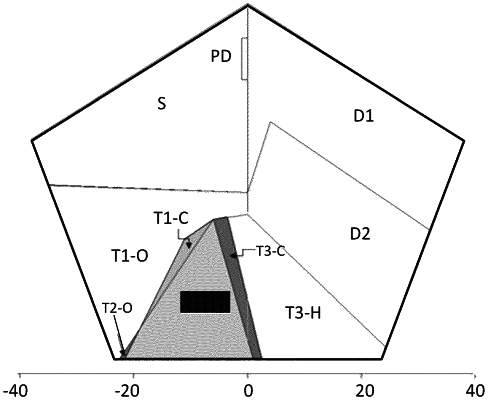| CPC G01N 33/2841 (2013.01) [G01N 21/3504 (2013.01); H01F 27/12 (2013.01); H01F 27/402 (2013.01); H02H 7/04 (2013.01); H01F 2027/404 (2013.01)] | 17 Claims |

|
1. A method of analyzing dissolved gas in an oil-filled transformer, comprising:
obtaining measurements of dissolved gas levels of a first number of gases in the oil-filled transformer;
determining relative levels of the first number of gases;
plotting a first number of points representing each of the relative levels of the first number of gases on a respective one of a first number of radial axes, each of the first number of radial axes being equally angularly spaced around an origin in a two dimensional coordinate system, each of the first number of radial axes representing a relative level of one of the first number of gases, the first number of points forming a polygon within the two dimensional coordinate system;
determining a centroid of the polygon;
determining a fault region in which the centroid of the polygon is located, out of a plurality of fault regions defined in the two dimensional coordinate system, wherein the plurality of fault regions are defined in a composite fault region map that is a composite of a first fault region map that defines regions that classify basic electrical faults within the oil-filled transformer, wherein the definition of regions in the first fault region map is not based on carbonization of cellulose within the oil-filled transformer, and a second fault region map that defines regions that classify faults at least partially based on carbonization of cellulose within the oil-filled transformer, wherein determining the fault region in which the centroid of the polygon is located comprises inputting the centroid of the polygon into a machine learning classification technique that generates, as an output, a classification of the fault region associated with the centroid, wherein the machine learning classification technique comprises a gradient boosting machine technique; and
classifying a fault experienced by the oil-filled transformer based on the determined fault region within the composite fault region map;
wherein the first Duval pentagon defines fault regions of T1, T2, and T3, the second Duval pentagon defines fault regions of O, C, and T3-H, and the composite fault region map defines fault regions that are coterminous within the fault regions of T1, T2 and T3 in the first Duval pentagon and the fault regions of O, C, and T3-H in the second Duval pentagon.
|